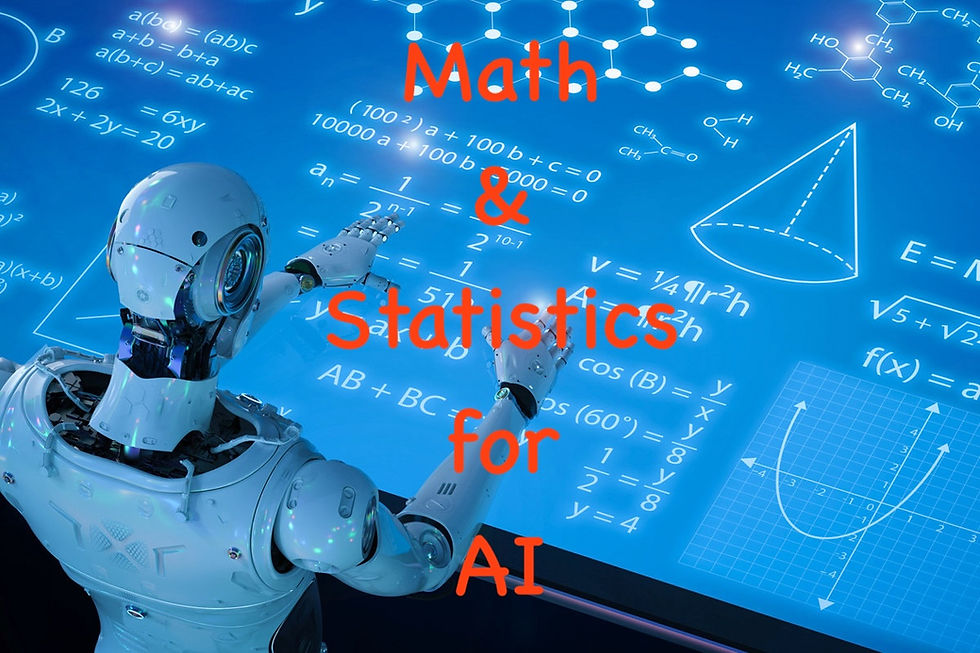Part 4: Understanding Logarithmic Functions and Their Significance in Data Science and Machine Learning
- Revanth Reddy Tondapu
- Jun 23, 2024
- 3 min read

In this blog post, we'll explore the concept of logarithmic functions, often referred to as "log," and understand their significance in data science and machine learning. We'll also demonstrate how to use logarithmic functions in Python to solve real-world problems. Let's dive in!
What is a Logarithmic Function?
A logarithmic function is the inverse of an exponential function. In simple terms, if you have an exponential function where a number is raised to a power, the logarithm helps you find that power.
Example: Understanding Exponents and Logarithms
Imagine you have $5 and you invest it in a bank that gives you a 5x return each year. If you start with $5:
After one year, you will have $5 * 5 = $25.
After two years, you will have $25 * 5 = $125.
This can be represented as:
( 5^1 = 5 )
( 5^2 = 25 )
( 5^3 = 125 )
Now, suppose you know you have $125 today and you want to find out how many years it took to grow from $5 to $125. This is where the logarithmic function comes into play.
The logarithm to the base 5 of 125 can be written as: [ \log_5(125) = 3 ]
This tells us it took 3 years for the investment to grow from $5 to $125.
Basic Logarithmic Properties
Logarithm of a Number to Its Own Base: [ \log_{10}(10) = 1 ] [ \log_x(x) = 1 ]
Logarithm of a Power: [ \log_{10}(100) = \log_{10}(10^2) = 2 \times \log_{10}(10) = 2 ] [ \log_{10}(1000) = 3 ]
Applying Logarithms in Data Analysis
Logarithms are particularly useful in data analysis when dealing with datasets that have a wide range of values. Let's look at an example where we compare the revenues of different companies using a bar chart.
Example: Visualizing Revenue Data
Suppose we have a dataset with the annual revenues of six companies. Here's how the data looks:
Company | Revenue (in billions) |
Amazon | 386 |
Uber | 11 |
Jindal | 1.5 |
Axis Bank | 5 |
Vedanta | 10 |
Tesla | 31 |
When you plot this data on a bar chart, Amazon's bar is so high that it flattens the bars for other companies, making it hard to compare smaller revenues.
Using Logarithmic Scale
By applying a logarithmic scale to the y-axis, we can make the comparison more meaningful.
import pandas as pd
import matplotlib.pyplot as plt
# Sample datadata = {
'Company': ['Amazon', 'Uber', 'Jindal', 'Axis Bank', 'Vedanta', 'Tesla'],
'Revenue': [386, 11, 1.5, 5, 10, ]
}
df = pd.DataFrame(data# Plotting with linear scale
df.plot(kind='bar', x='Company', y='Revenue')
plt.title('Company Revenue (Linear Scale)')
plt.show()
# Plotting with logarithmic scale
df.plot(kind='bar', x='Company', y='Revenue', logy=True)
plt.title('Company Revenue (Logarithmic Scale)')
plt.show()Using a logarithmic scale (logy=True), the bars for smaller revenues become more distinguishable, allowing for better comparison.
Logarithmic Transformation in Machine Learning
Logarithmic transformations are used in machine learning to handle skewed data and outliers. For instance, in a dataset containing personal incomes, a few high-income values can skew the analysis.
Example: Predicting Loan Approval
Let's say we have a dataset with features like credit score, income, and age, and we want to predict whether a loan should be approved.
import numpy as np
# Sample data
data = {
'Credit_Score': [700, 650, 800, 750],
'Income': [32000, 77000, 550000, 45000],
'Age': [30, 45, 35, 50],
'Loan_Approved': [1, 0, 1, 0]
}
df = pd.DataFrame(data)
# Log transform the Income column
df['Log_Income'] = np.log10(df['Income'])
print(df)By applying a logarithmic transformation to the Income column, we bring the high-income values closer to the scale of other values, reducing their influence on the model.
Earthquake Magnitude: A Logarithmic Scale
Earthquake magnitudes are measured on a logarithmic scale. An earthquake of magnitude 5 is 10 times more powerful than one of magnitude 4. This logarithmic relationship helps in understanding the significant differences in energy released by earthquakes of different magnitudes.
Conclusion
Logarithmic functions are powerful tools in data science and machine learning, helping to manage and analyze data more effectively. Whether it's visualizing data with a wide range of values or transforming skewed data for better model performance, understanding and applying logarithms can greatly enhance your data analysis capabilities.
We hope this post has provided you with a clear understanding of logarithmic functions and their practical applications. Stay tuned for more insights into mathematics and statistics for data science and machine learning. Happy learning!
Komentarji